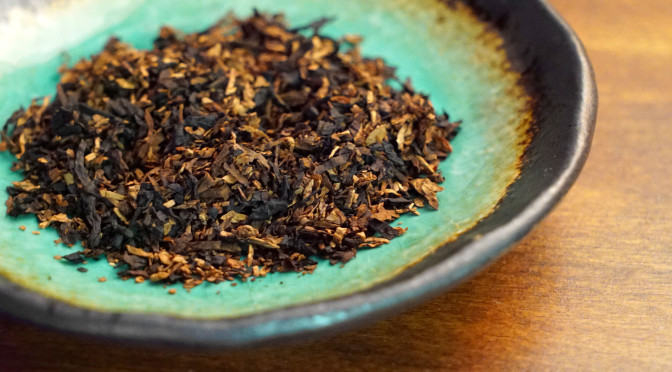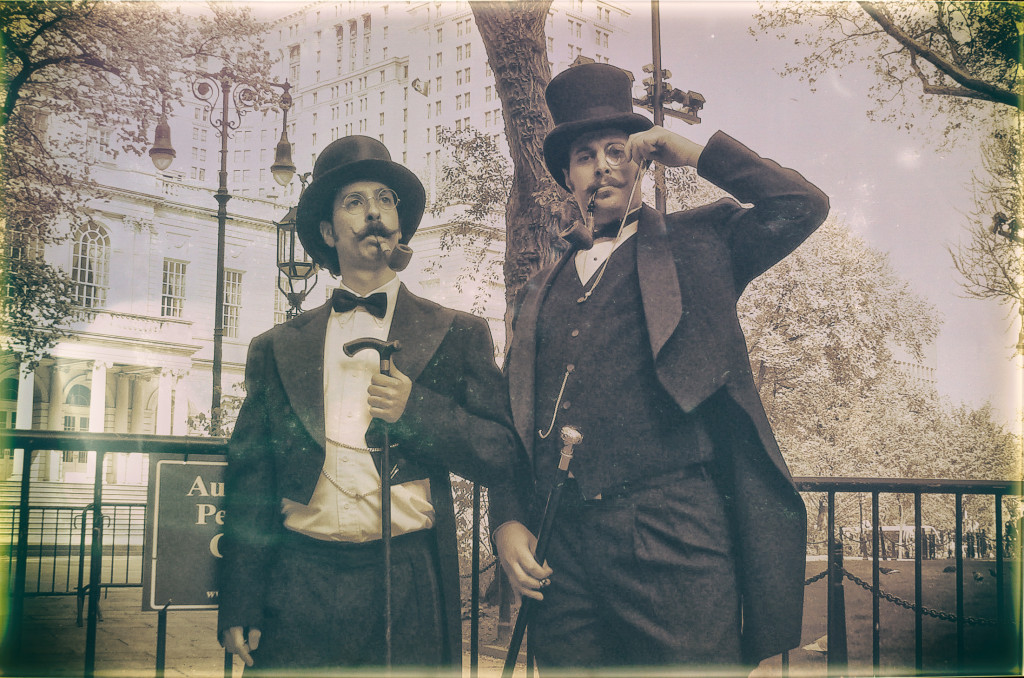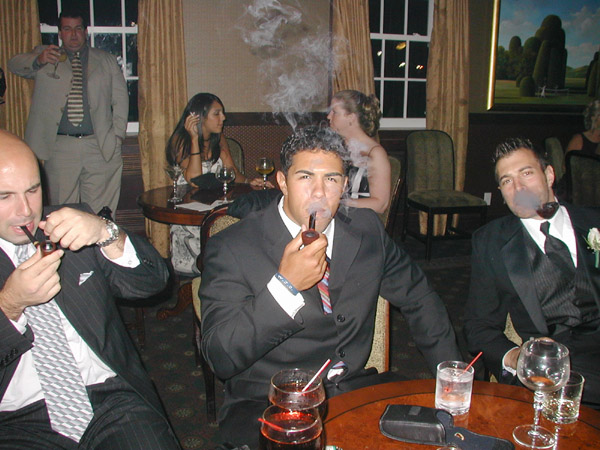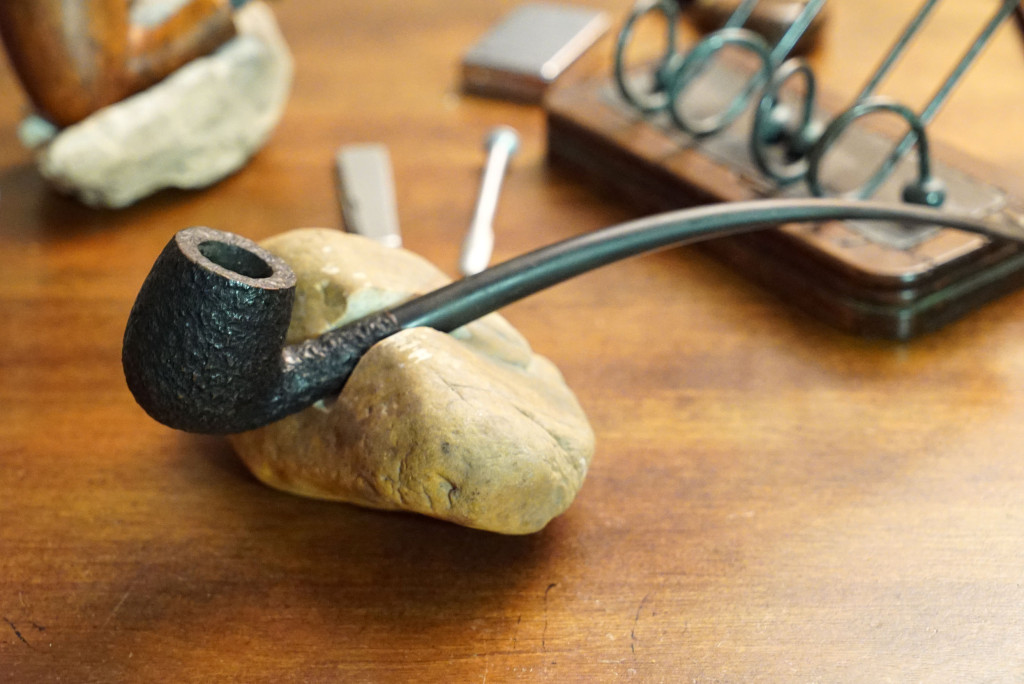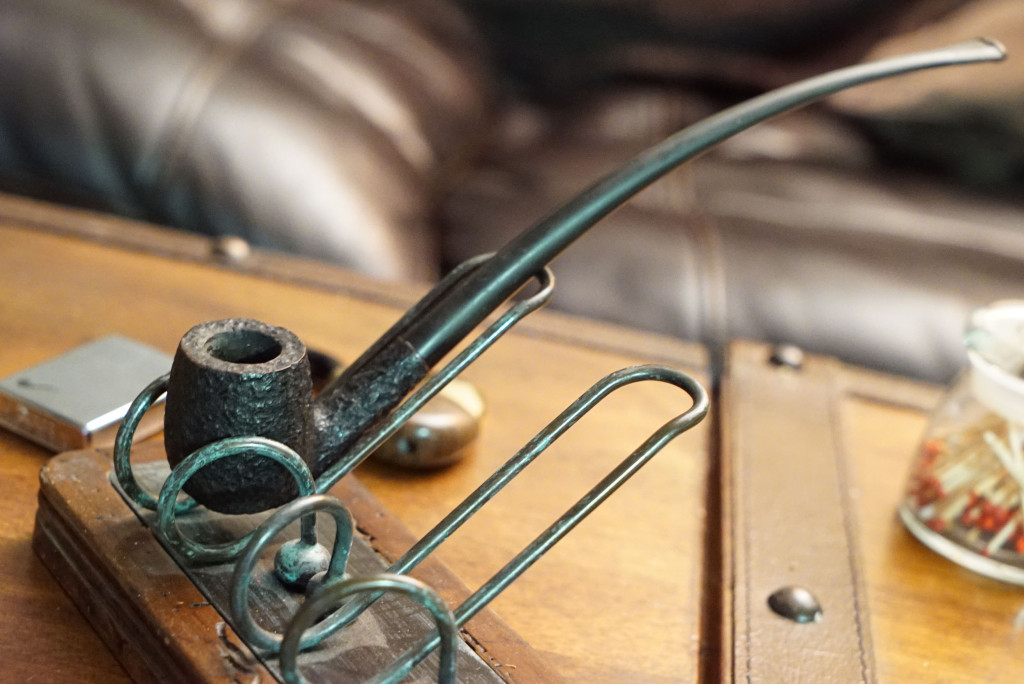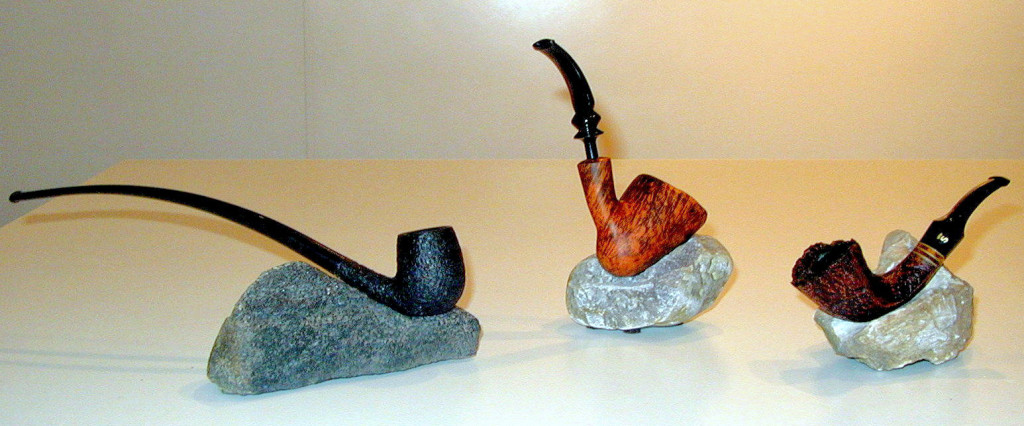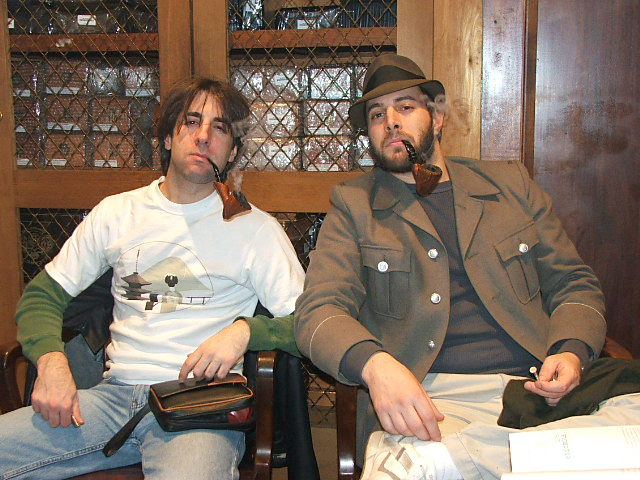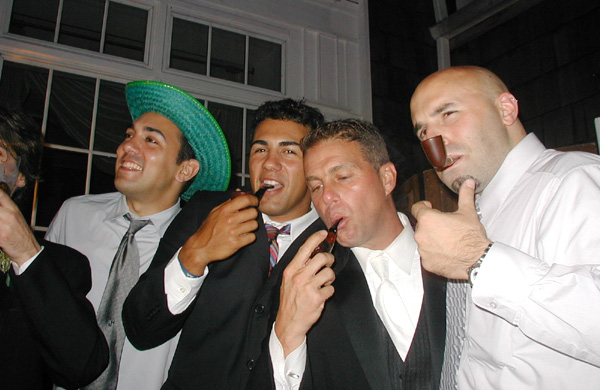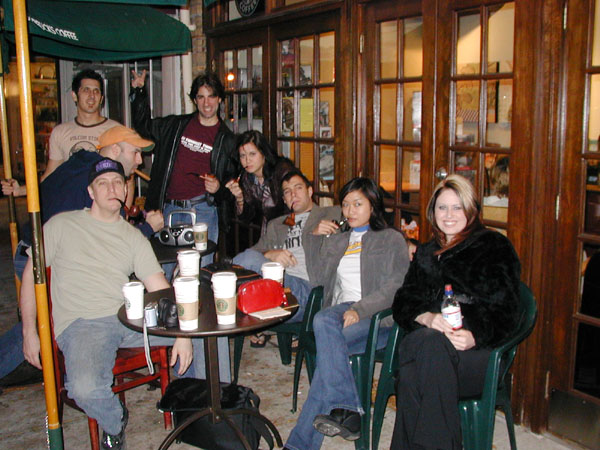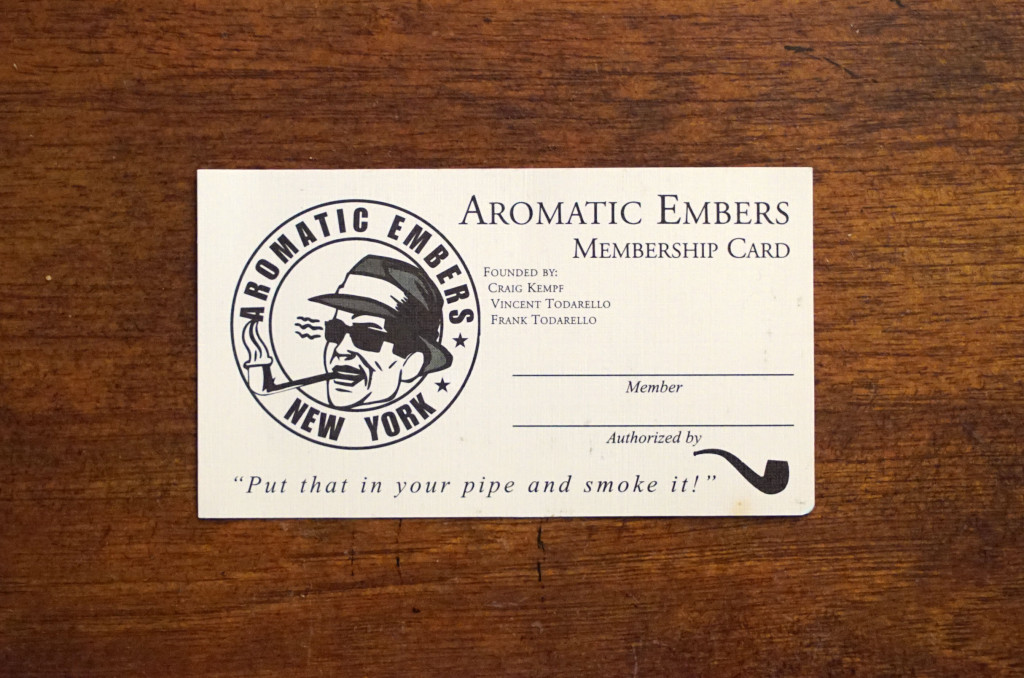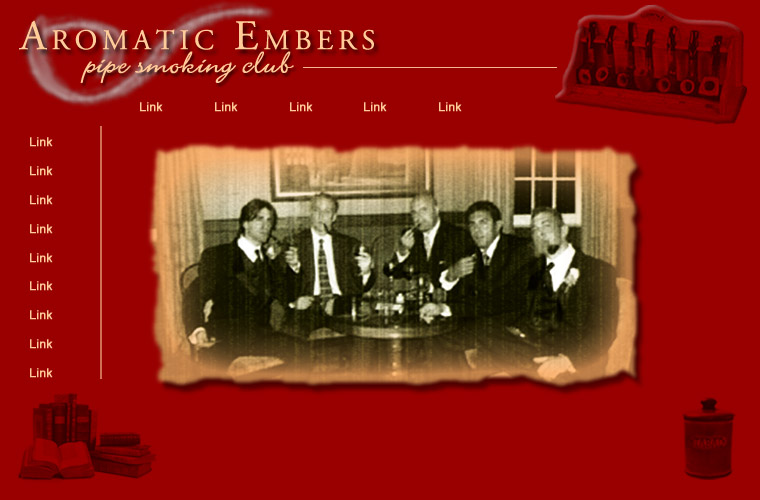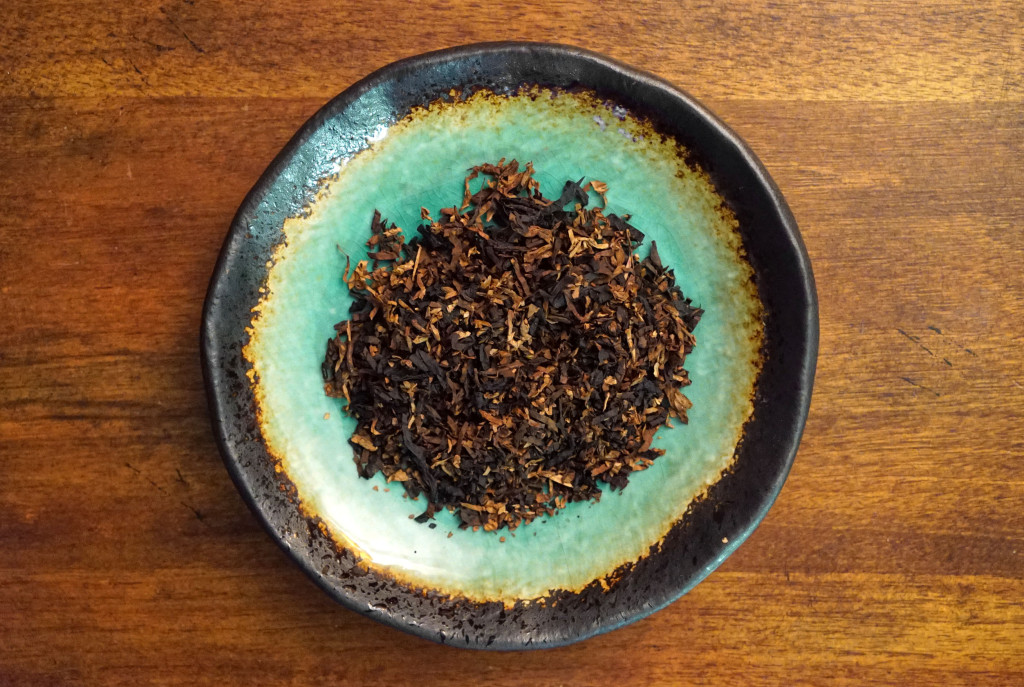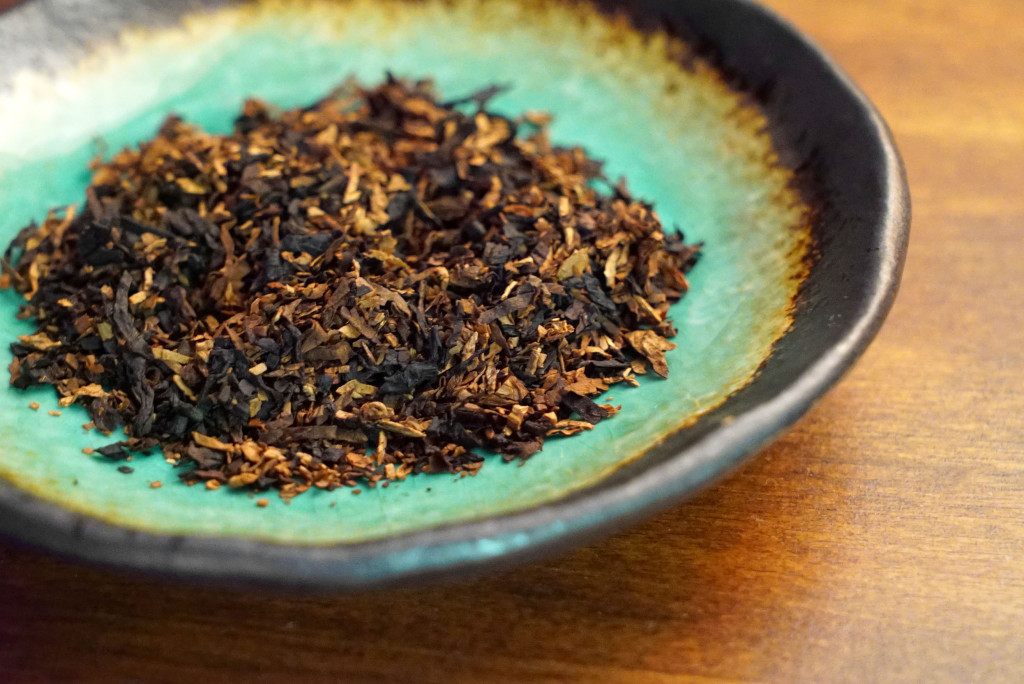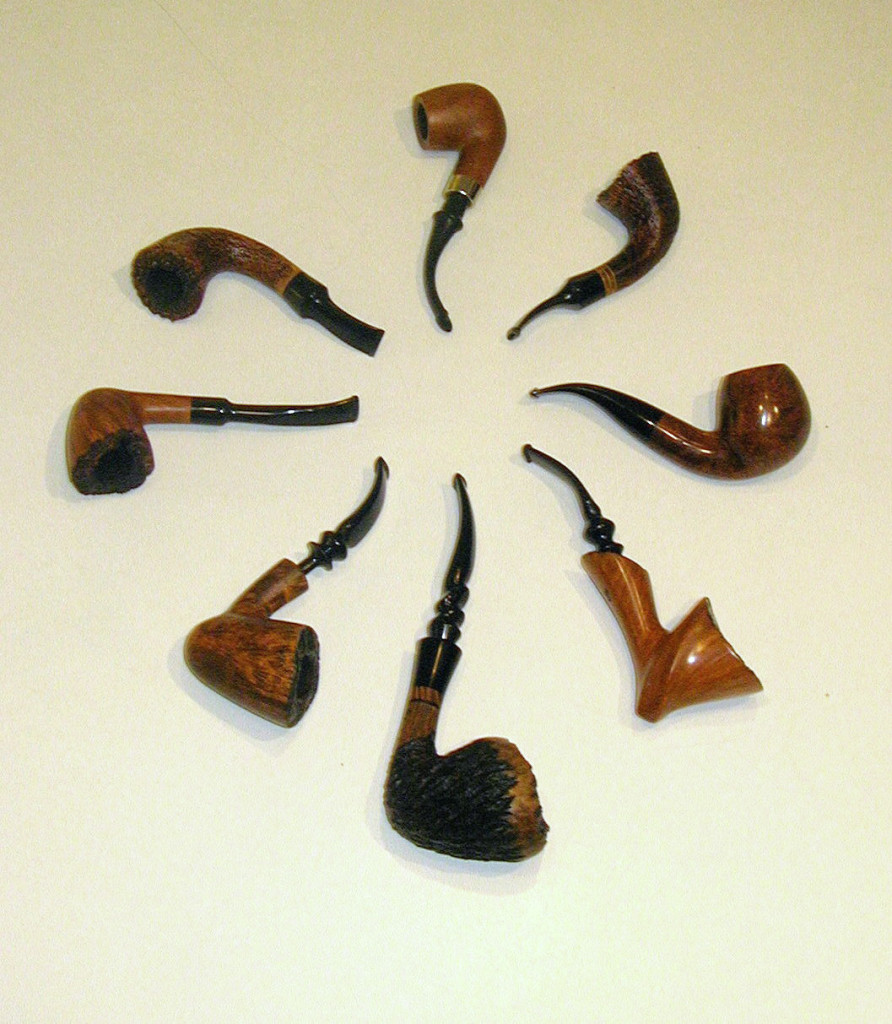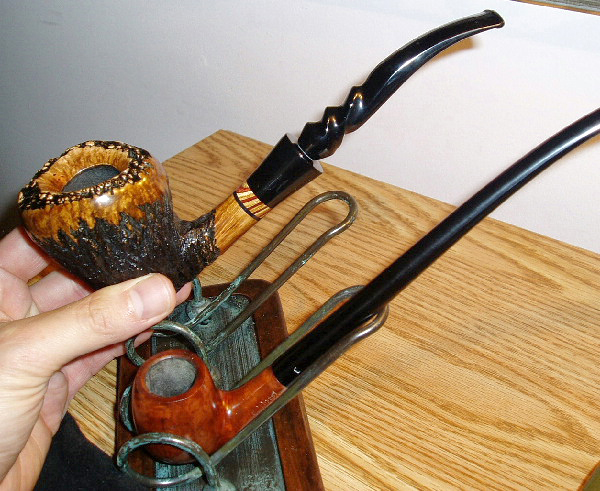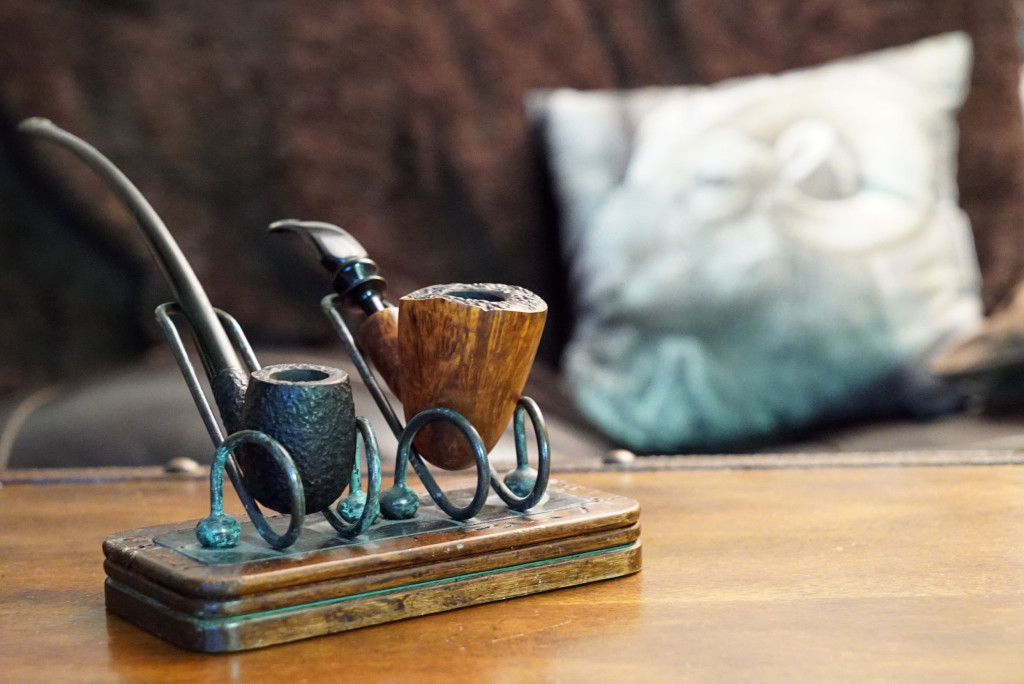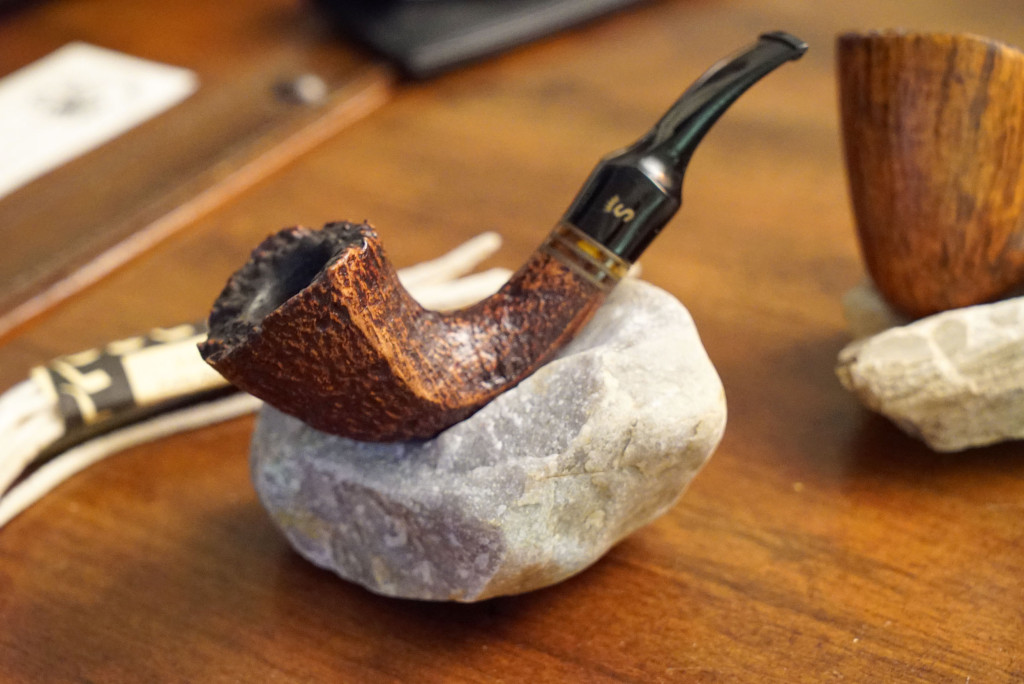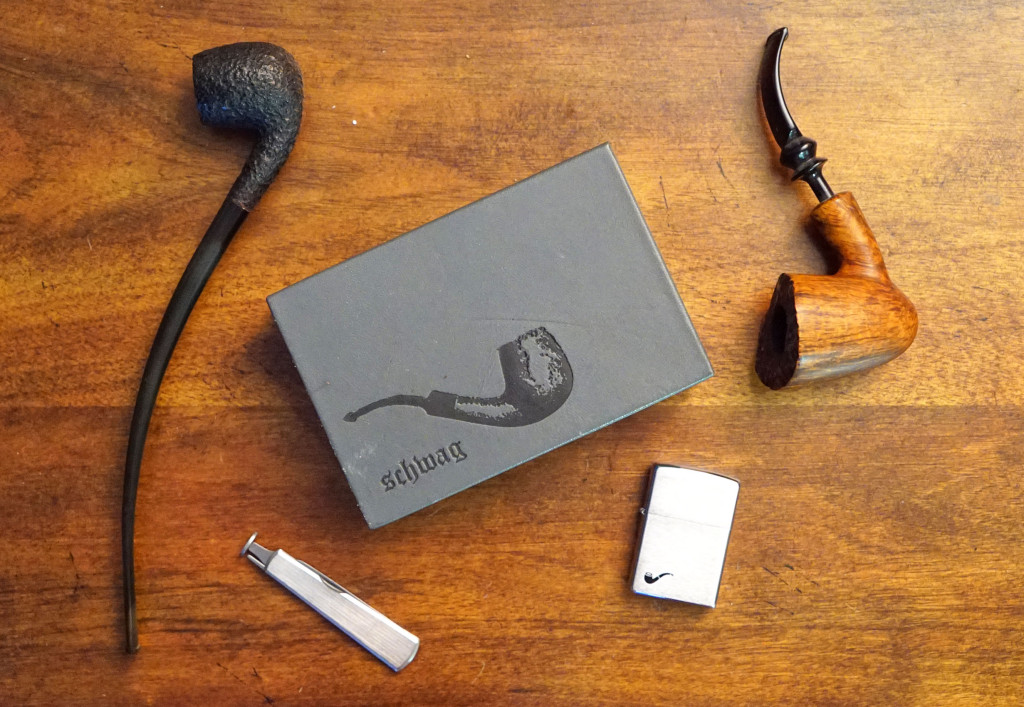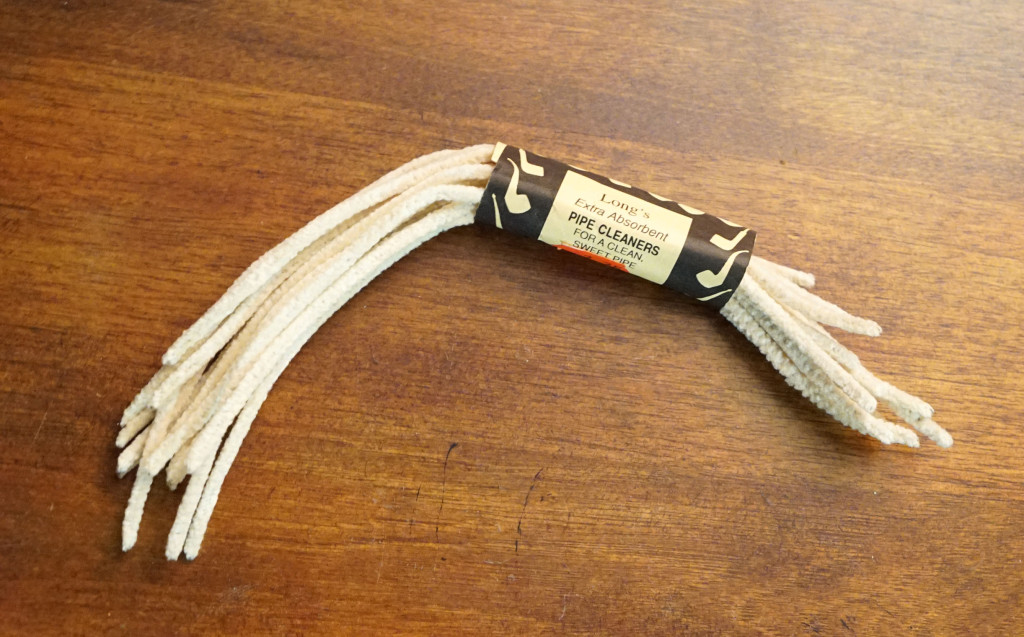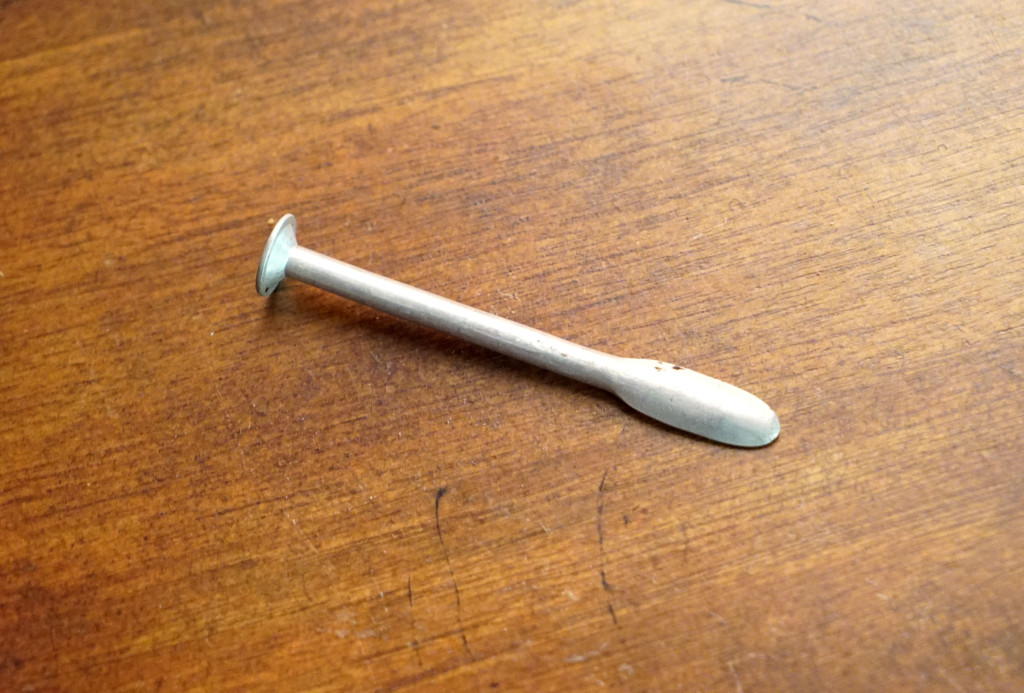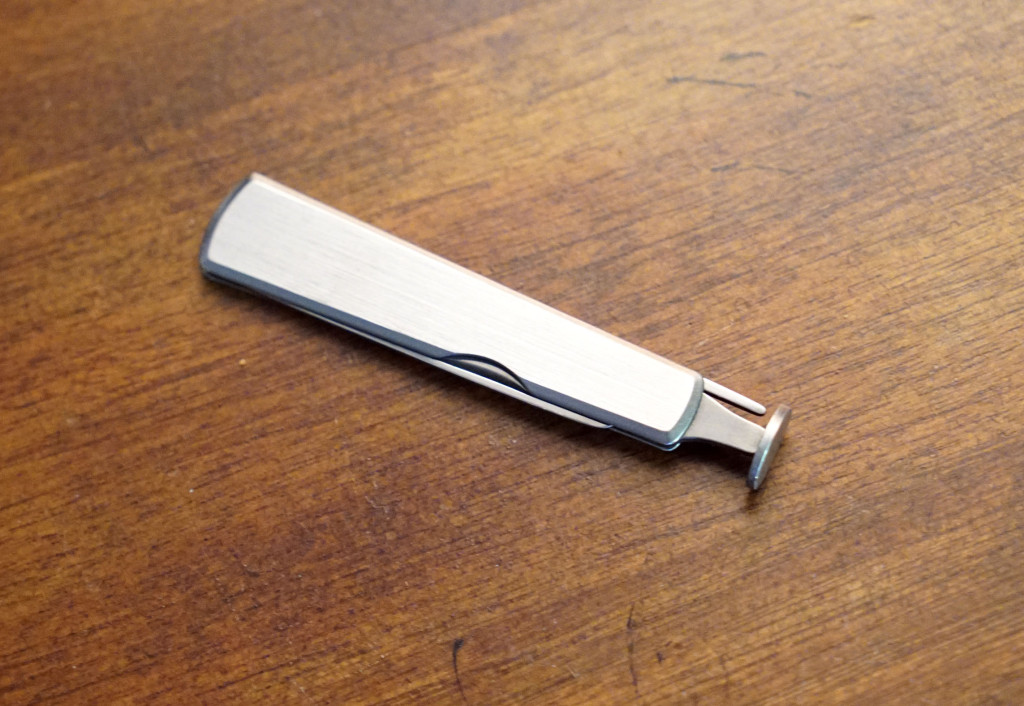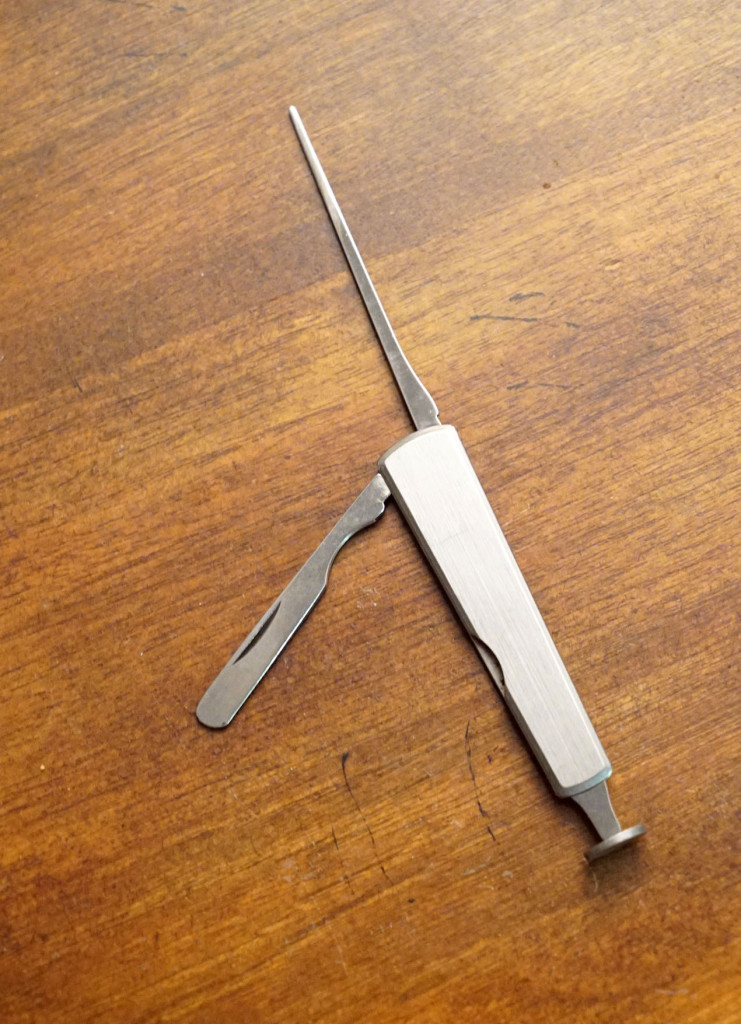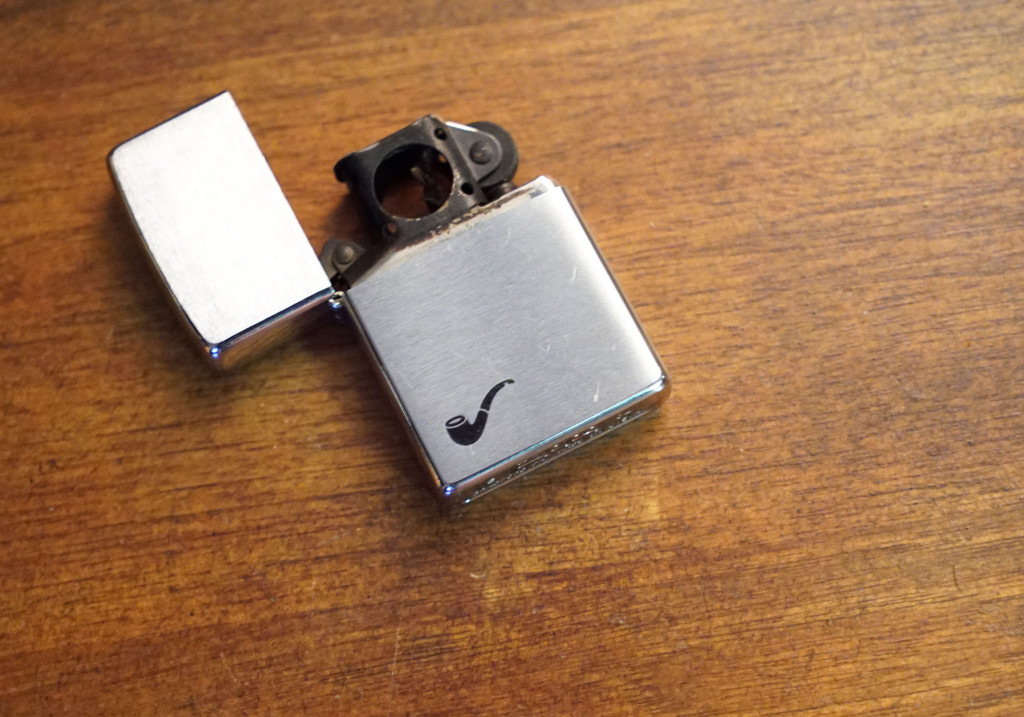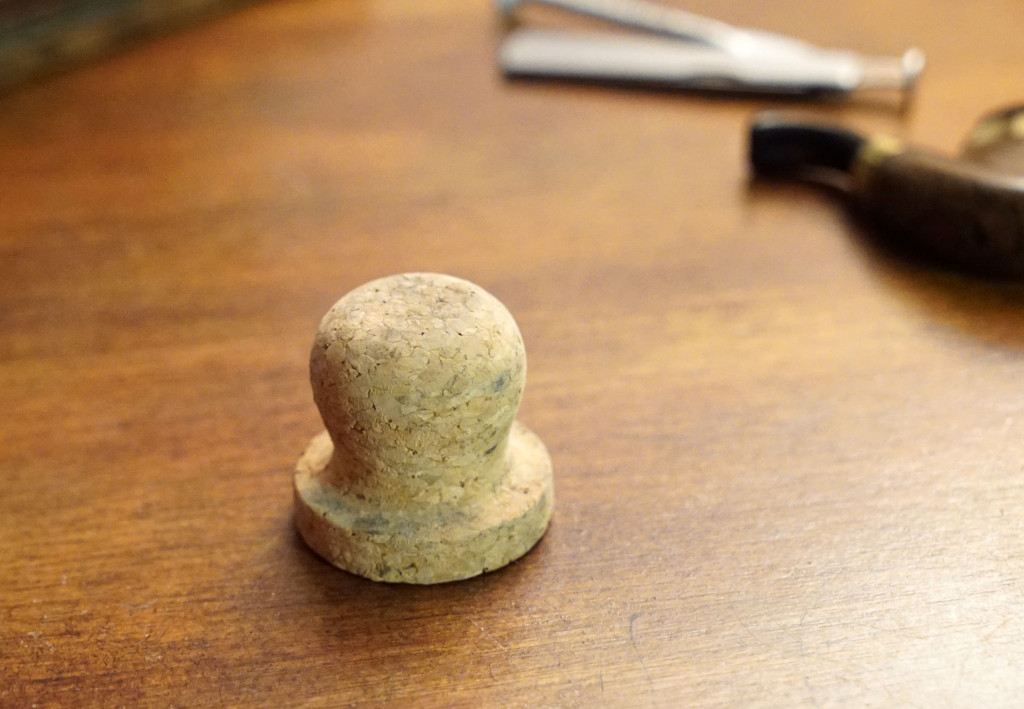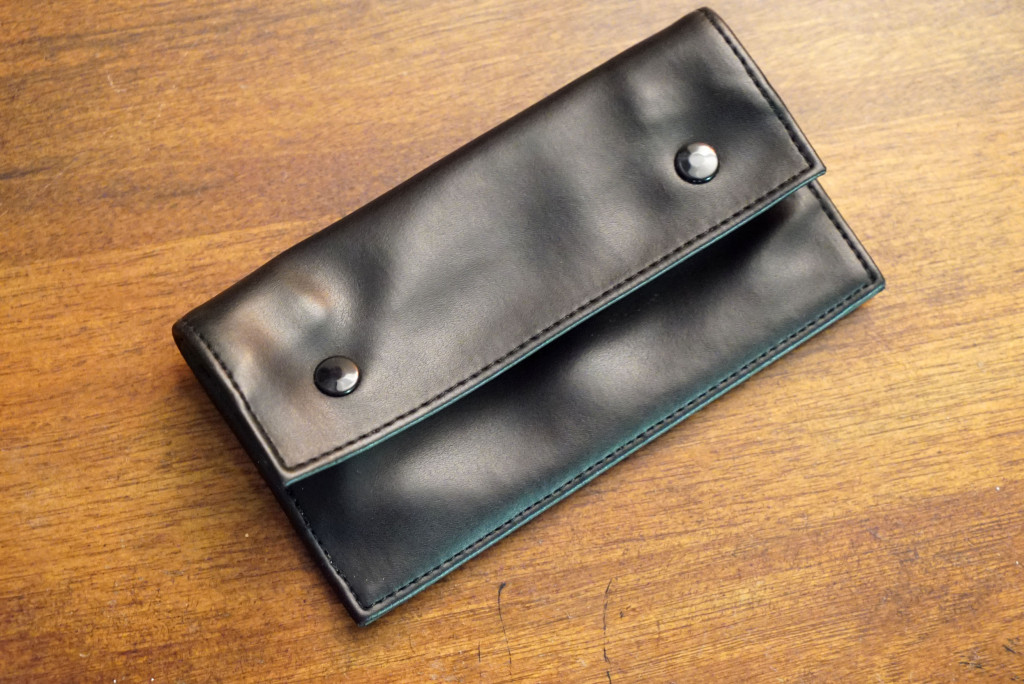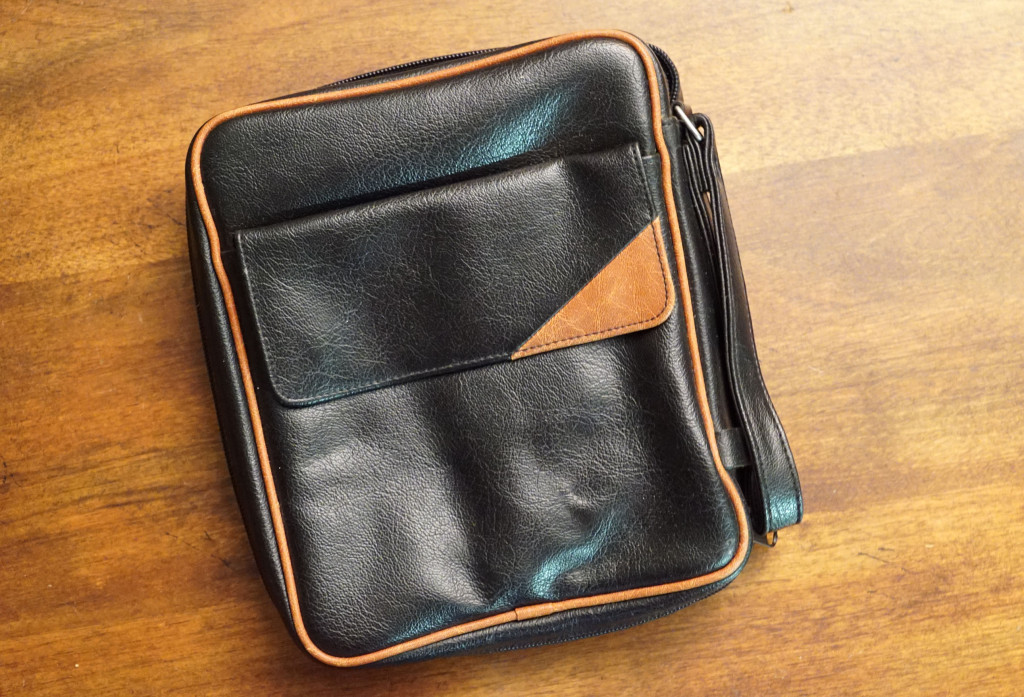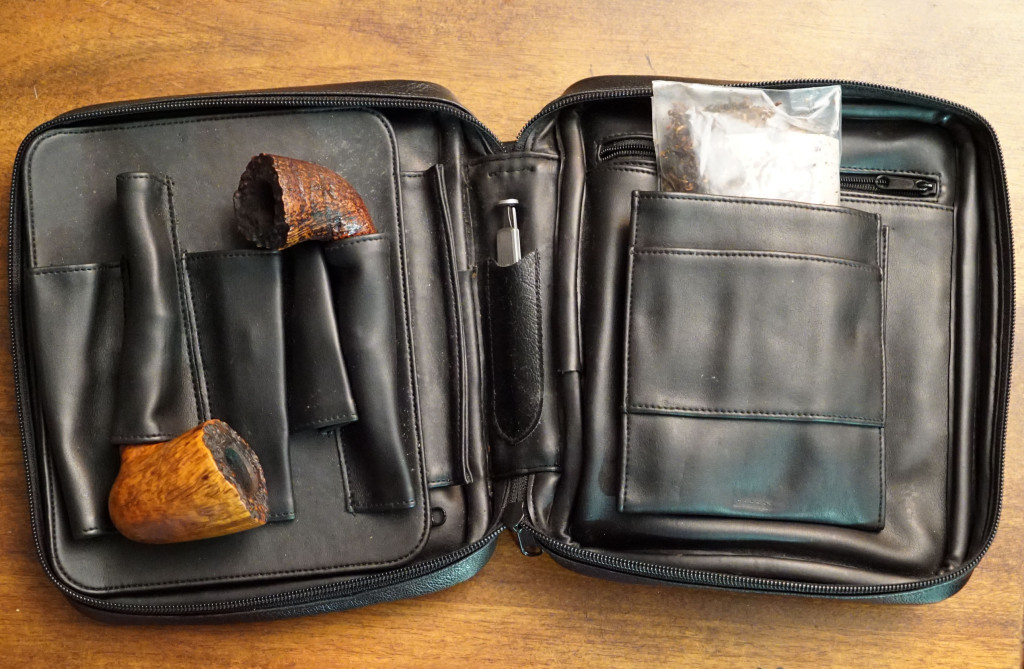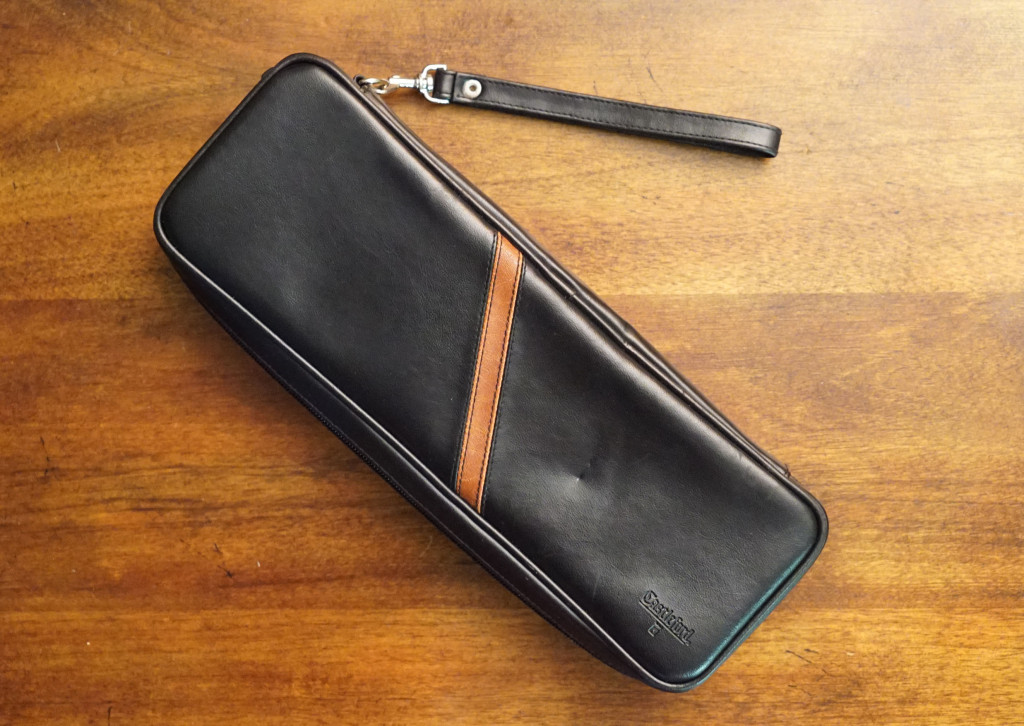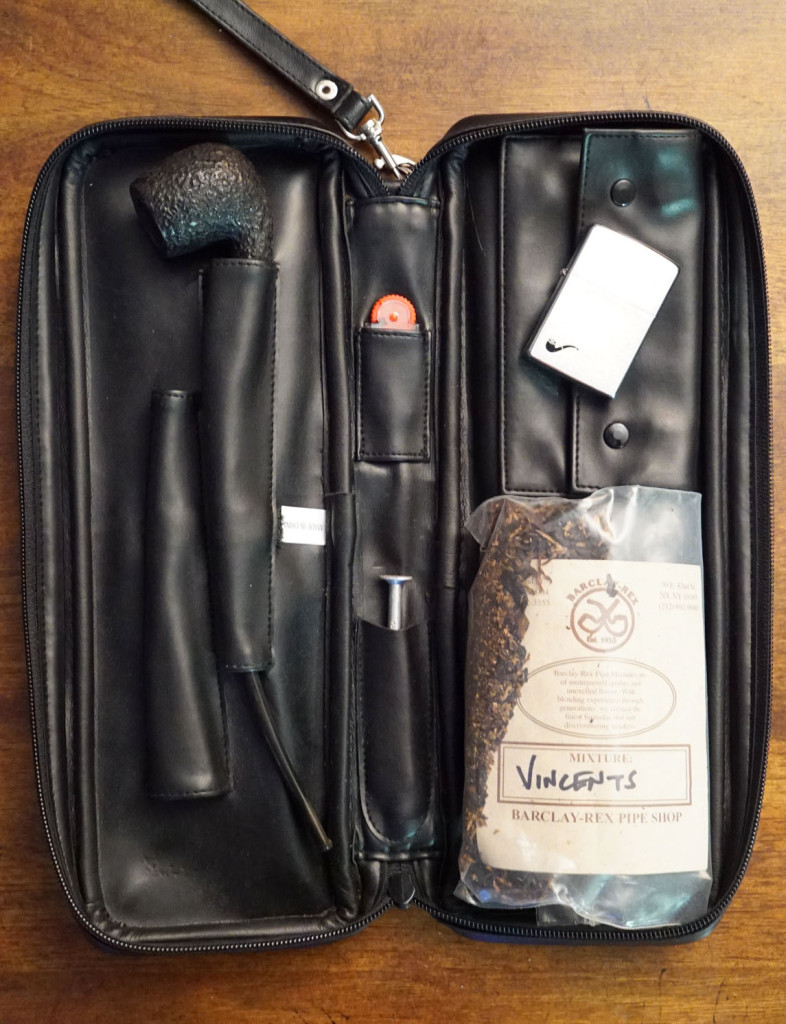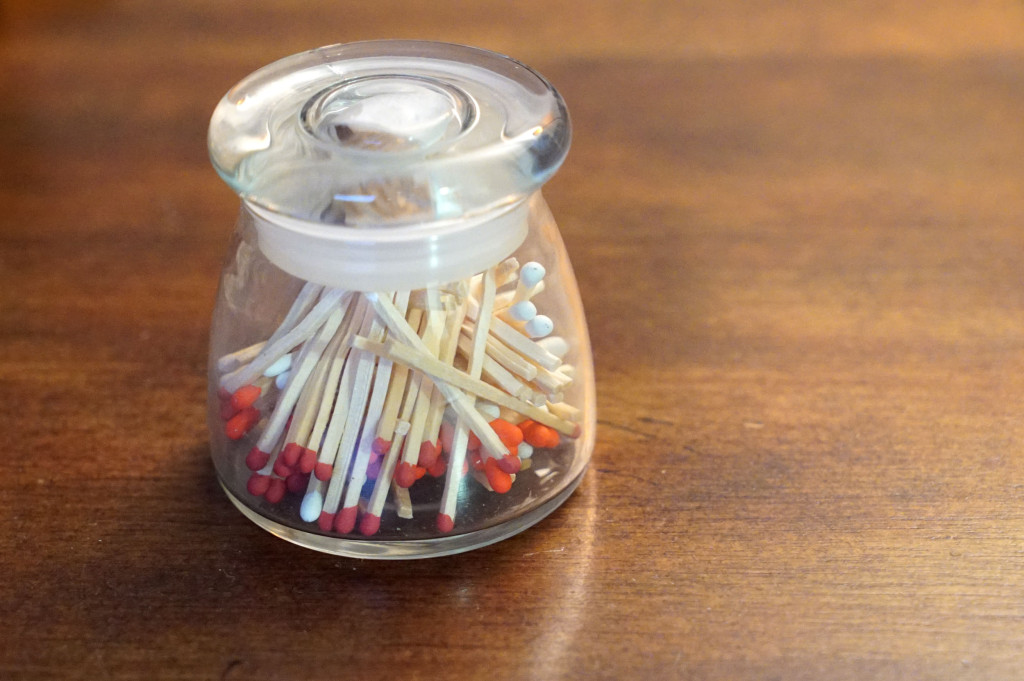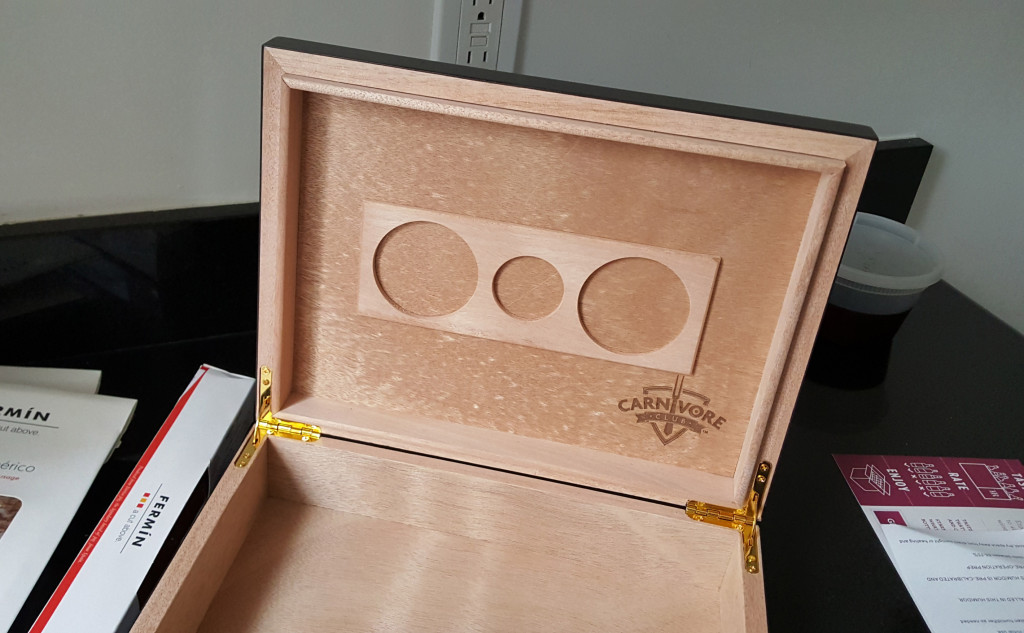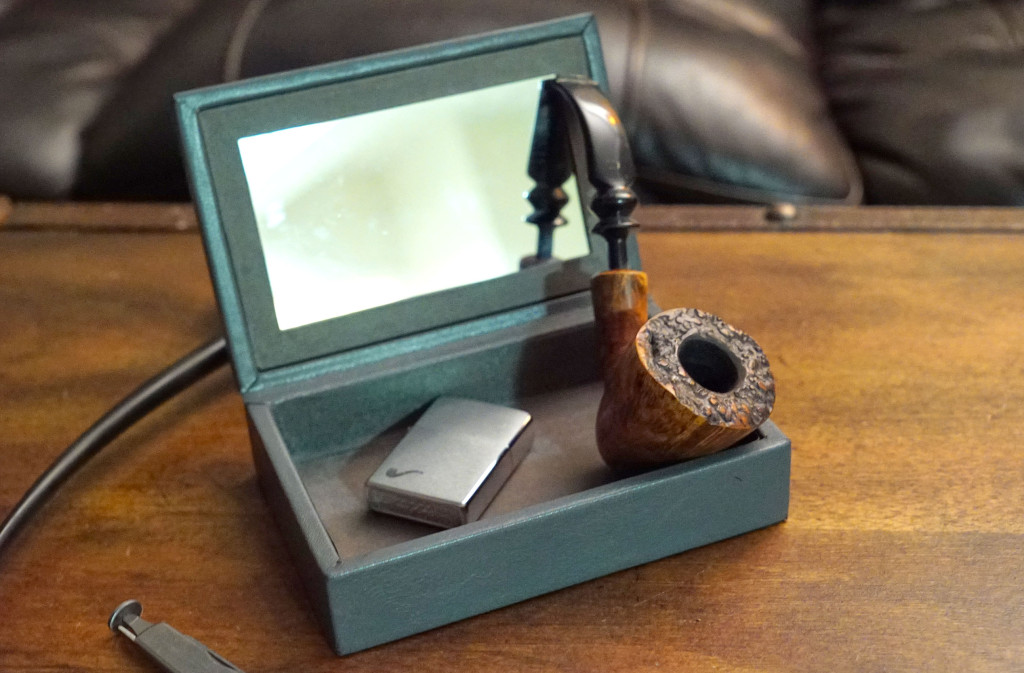Something that many discerning men enjoy after a steak is scotch. But these days, there are a dwindling few who have a chance to partake in the OTHER delight of a post-steak meal: a good smoke. Whether you’re a cigar or a pipe guy, or even one of those ridiculous e-cigarette fanatics, NYC has pretty much fucked your world when it comes to lighting up at the table as you wait for the bill.
Look – I get it – no one wants to go home smelling like an ash tray. And by now it’s old news that NYC has a ban on smoking in food establishments. There are a precious handful of places where you can still smoke, but there’s one thing I always thought was unfair about the smoking ban: PIPES SMELL AWESOME!
Pipe smoking is real altruism: I know it’s bad for me, but you’re getting enjoyment from it because the smoke smells fucking fantastic. I’m not really a cigar guy. Occasionally I will have one. I’m not really a cigarette person, either. If I’m out drinking and a friend offers, I might smoke one to be social. Generally cigars and cigarettes smell like shit to me, and they don’t taste all that great to boot. I DO like a clove cigarette, on occasion. And I DO like pipe tobacco. Those both taste and smell excellent, and typically neither product gets inhaled, so they’re slightly better for you than a cigarette. I guess mouth cancer is less shitty than lung cancer.
Why pipes, though? Who gets into that kind of thing? People who want to look distinguished, that’s who.
I began my foray into pipe smoking sometime in 2003 or 2004. A friend sent over a random video of himself and a friend – set to classy jazz music of course – puffing away on a long churchwarden pipe like some kind of hobbit.
A churchwarden pipe, by the way, is named so because men who kept watch over churches at night (wardens of the church) would often want a long-stemmed pipe that they could rest on their belly as they sat back in a chair.
Anyway I saw that video from my friend and I laughed. But I thought, “This is actually pretty fucking cool. I need to get one now.” In fact a small group of us all picked up some pipes soon after, and we started a club called the Aromatic Embers Pipe Smoking Club.
It was great! Every week we would meet at a local Starbucks and puff away in the outdoor seating area.
Without fail people would comment about how great it smelled. We had membership cards, a nice logo, and we were even in the process of building a website.
So here are a few things you’ll need to know about pipe smoking, that way you’re ready to rock when you decide to take up this healthy and enjoyable habit.
Types of Pipe Tobacco
Astoundingly similar to scotch, pipe tobacco can vary from smoky like baseball glove leather, to sweet like caramel. In fact I often pair a smoky scotch with something like a Latakia tobacco, which has the similar medicinal, iodine-y aroma of peat moss mixed with leather.
Those types of tobaccos are generally less pleasant to smell when burning, but they’re still not as noxious as a cigar or cigarette. They’re not UNpleasant by any means; they just have a characteristic odor that takes a little getting used to.
Other tobaccos are infused with flavorings and even sugars to make them taste different or become very aromatic and scented when burning. It’s as if you’re burning a nice-smelling candle in the room. The smoke does tend to cling, though, so make sure you have good air circulation. If not, you may soon find yourself wading through a thick fog of pipe smoke. Here’s a more specific look at the various types of tobacco:
Major Breakdown of Tobacco Styles
Aromatic: During the manufacturing process, flavors or “casings” are added to the tobacco, as mentioned above. Some of the most common are vanilla, nougat, cherry and chocolate. Depending on the amount of flavor used, a blend in this category can also be deemed semi- or lightly-aromatic.
Non Aromatic: Natural tobaccos that derive flavors, in many cases, through aging, curing, smoking or fermenting. This technique increases the sweetness and/or flavor without using sugar additives.
English Blend: Until 1986, additives were not allowed in English tobaccos. While non-aromatic tobaccos are manufactured all over the world, a true English blend is one containing Oriental tobaccos, most notably Latakia. The most common English blends consist of Latakia, Virginia, and Perique. Depending on how much Latakia is mixed into the blend ultimately determines the overall strength of the mixture, described as mild-, medium-, or full-bodied.
Blending Tobaccos
These tobaccos are often blended together to form different flavor profiles in commercially packaged and loose pipe tobaccos.
Virginia: This is the most common and mildest of all aromatic blending tobaccos. With the highest natural sugar content, it can burn hot and “bubble” or boil while smoldering in the pipe bowl. It lights up easily, and has a sweet taste, which increases when aged prior to blending. It is sometimes sticky or damp.
Burley: This has a thicker leaf than Virginia, with a soft, nutty flavor. It burns slowly and contains little sugar. As such it is commonly used in high sugar blends to keep them from burning too hot. The color ranges from mahogany to light brown, and is typically air-cured for 30-60 days in large barns.
Spice or Taste Tobaccos
These are blending tobaccos that are used like seasonings. You add a particular amount to your blend to give it a characteristic flavor or unique kick. Examples would include varieties like Perique, Brazil, Kentucky, Oriental and Latakia. These are all commonly found in English blends.
Perique: This is a dark tobacco from St. James, Louisiana that’s spicy in flavor. It is a rare, slow burning and strong-tasting tobacco. Production is small, so its value is high. Perique’s cured leaves are put in large oak barrels under heavy pressure and fermented for a year or longer. The aroma is full bodied. The nicotine content is very high, so Perique isn’t smoked by itself. The most you usually see in a blend is about 5 %, and it’s usually mixed with Virginia.
Brazil: A dark tobacco with a strong, sweet flavor.
Kentucky: This is actually a special fire-cured Burley tobacco produced in Kentucky. It’s very aromatic and unique. The nicotine content tends to be high, so it is used sparingly.
Oriental: A generalized grouping of dry tobaccos that includes Latakia and is known for unique “spice” flavors. Tobaccos in this category come from Russia, Macedonia, Turkey, Greece, Cyprus, the Balkans and Syria. Some popular Macedonian tobacco varietals include Komotini, Samsun, Xanthi, Drama, Serrus, Izmir, Yenidji, Cavella and Bursa.
Latakia: This is a full-bodied dark, dry tobacco from Cyprus and Syria that gives off a smoky aroma that’s similar to burning tree leaves, peat moss or baseball glove leather. Latakia is a powerful tobacco: this is the “smoky scotch” of tobaccos that I discussed earlier. It is produced by smoke- and fire-curing the leaves over spices, herbs and aromatic woods. This is very similar to the process of peat smoking barley prior to fermentation in the whisky and scotch making process. It is precisely why the two items have such similar flavors and aromas. English blends sometimes contain up to 50% Latakia, and some smokers will put nothing in their pipes but 100% Latakia. Balls. One thing to note here is that this variety can sometimes get ashy toward the end, since it is such a dry tobacco. It rarely “bubbles” or boils as you smoke it, as it tends to burn cool (low sugar content).
Side-Note About Latakia: The smoking process associated with Latakia tobacco was first discovered when farmers forgot they had stored excess tobacco in the rafters of a barn where they used to cook. The smoke from all the burning wood wafted up and flavored the tobacco. When the farmers found the old tobacco in the rafters, this new, enjoyable flavor style was born.
Tobacco Cuts & Curing Processes
Like steak, there are several cuts of tobacco. However while each cut of steak has a different flavor because it’s from a different part of the animal, tobacco cuts have a more physical connotation: it’s all about the shape, size and manner of how the leaves are cut.
The curing and processing of tobacco is analogous to steak aging, marinating and applying varied cooking methods. The tobacco leaves can be dried, flavored and processed in a variety of ways prior to smoking, all to different results and imparting a wide variety of flavors.
Here’s a quick breakdown of the information you’ll need to know when you go out and buy some tobacco:
Cavendish: This special heating and curing process brings out the naturally sweet flavor of tobaccos. The result is a mild, light tasting and easy to pack product. Cavendish can be produced from any tobacco type, but mainly Virginia tobaccos are used because of the high sugar content that naturally occurs in the leaves. Examples include Black Cavendish, Navy Cavendish (aged with rum) and English Cavendish (fire-cured tobacco which is steamed and then stored under pressure to permit it to cure and ferment).
Casing: Simply put, this means adding flavoring to a tobacco. This is usually done by producing a fluid mixture of sugar, honey and/or other kinds of aromatic sweeteners and then soaking the tobacco. The goal is to produce a tobacco with a sweet and smooth aroma.
Air-Cured: Drying tobacco naturally, and sheltering it from sunlight in large barns causes sugar content to crystallize on the leaves. It usually takes about three months.
Fire-Cured: This drying and curing method is achieved by a wood-fired smoke fumigation.
Sun-Cured: Most Oriental tobaccos are cured by simply baking in the sun, which is why they tend to be drier than other varieties.
Cake: This is tobacco that has been soaked in honey, which acts as a bonding agent as well as a sweetener.
Spun-Disc or Plug: Similar to cake, this is tobacco that has been soaked in a bonding agent (like sugary syrup or honey), but then pressed together by packing it into round molds or logs before packaging. If a piece is cut off its called a plug.
Flake Cut: Tobacco packaged as large, flat flakes. It must be rubbed out to separate the flakes, or folded and then simply inserted into a pipe and lit.
Rubbing Out: While often used as a term for masturbating, in the world of pipe tobacco it means rubbing flake or plug in the palm of the hand to loosen the tobacco prior to smoking.
Ready Rubbed: A flake-cut tobacco that has been rubbed out before packaging.
Shag: Tobacco that has been shredded very finely. This is what Sherlock Holmes smoked, which, at that time, was supposedly considered an inferior product.
Ribbon Cut: Tobacco cut into long, thin ribbons, though not as long or as fine as shag.
Cube Cut: Pressed tobacco chopped into small square pieces.
Navy Cut: Traditionally the tobacco was put in a long thin canvas tube and twisted up very tight. After time it became a thick rope of tobacco, approximately an inch in diameter. Similar to spun disc, if a piece was cut off it was called a plug. It is also commonly sliced, and is generally a slow burning tobacco.
Styles of Pipes
Similarly important to WHAT you’re smoking is the vessel in which you’re smoking it. The pipe you choose is an extension of yourself; it is a personality marker. Like fashion or clothing style, it is a deeply personal matter. It may even be the kind of Harry Potter wand bullshit where the pipe chooses you, rather than you choosing the pipe. You may be surprised in what ends up being your “fit.”
Most commercial or good quality pipes are carved from high density hard woods, like briar, that won’t ignite and turn to charcoal with frequent burning. This dense wood often has some pretty cool patterning in the grain as well.
However some are made from meerschaum, which is a mineral deposit that is carved and later polished with hardened bee’s wax. These are typically ornately designed, like sculptures.
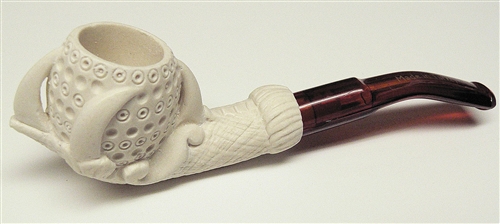
The meerschaum pipes will tend to turn slightly yellow over time as they become seasoned and used, with a dark brown or black interior in the bowl. They are said to impart a sweetness to the smoke that you don’t get with a wood pipe.
Other pipe styles are more natural, like those made from dried gourds, calabash pipes, or corn cobs. The calabash, which has a removable meerschaum bowl topper that traditionally rested in a hardened, hollow gourd, is what Sherlock Holmes smoked.
I suppose we could throw glass pipes and hookah pipes into the mix, but those are generally being used for illegal drugs, dried fruit or more harsh blends of non-pipe tobacco that aren’t very pleasing. Those pipes are more difficult to carry around for every day use too.
If you see the phrase “estate pipe,” it usually means that the pipe was used and is now being re-sold. Nice for decoration, perhaps.
In the realm of wood, where we will remain, there are “free-hand” natural cut, rough top, and smooth varieties. Below, the top pipe and right pipe represent smooth, elegant styles – more refined. The bottom, top right and top left represent natural cut styles – more rustic. On the left and lower left, you’ll see smooth styles but with rough tops. And on the bottom right you’ll see a stylized smooth pipe that still retains a natural, rough looking shape. As you can tell, there are lots of pipe styles out there. Picking a single one that suits you is often difficult. That’s why pipe smokers tend to collect several pipes, and choose which to smoke depending on their mood.
A closer look at the bottom-most natural cut, free-hand pipe:
I apologize for the repeat photos below, but I’m popping them in so you don’t have to scroll back up to see what I’m talking about.
In additional to the overall look, there’s also the stem length. Longer stems allow the smoke to cool down before it gets to your mouth, making for a more relaxed and smooth smoke. However, a long-stemmed pipe is not the most convenient thing to tote around and carry for the evening. As such, a chuchwarden pipe might be better suited for long bouts of reading or relaxing by the fireplace.
As you saw from the pipe wheel up above, a few of us prefer the traditional bowl style, or a smooth style, while others like a rustic horn pipe shape or a free-hand. Here’s a closer look at my horn:
It’s all a matter of preference. There really isn’t a difference on many of the styles other than what I mentioned about the stem length. However if you notice, in the image of the natural cut pipe, the pipe has a very large and deep bowl. When comparing the natural cut to the small churchwarden bowl, the natural pipe may stay lit for an hour as opposed to 15 or 20 minutes for the “churchie.”
Same goes for these two pipes below. The churchwarden on the left is about half as deep as the rustic/natural topped pipe on the right:
These things need to be considered before lighting up or leaving the house with your pipe gear.
Pipe Gear
Pipe gear can range from tools and accessories to satchels and pouches. There’s a LOT of cool stuff you can pick up for your new and awesome hobby. Below are some examples:
Pipe Cleaners: Yes… these are actually used for something other than children’s craft-making. You stick them down the stem to remove excess gunk, sludge, moisture, tar, spittle, you name it…
Pipe Nail: A poor man’s pipe tool, this is primarily used for tamping down your tobacco as it burns (to keep a compact but well-breathing ember/smolder going). At the end of your smoke, the flattened point can be used to scrape out the ash and gunk. Picking up a pipe nail will only run you a buck or two at most.
Pipe Tool: A full fledged pipe tool looks a bit like a folding pocket knife. One side is a scraper, the other side is a poker. And the flat bottom portion is for tamping down your tobacco, like a pipe nail. Fancy pipe tools can range from $10 to $100 depending on the craftsmanship and materials involved.
Pipe Lighters: Special lighters like this Zippo are made for lighting pipes, as they have a cut-away hole for holding the lighter sideways, with the hole hovering over the bowl of your pipe as you light up.
Pipe Knocker: This cork doo-dad is for tapping against the side of your pipe bowl to get excess out before scraping out with a pipe tool. It’s safer than using your hand (burns suck), and it also protects the finish of your pipe so you don’t ruin it by tapping the bowl against something that could scratch or nick the wood.
Pouches: Simple. This accessory is for holding loose pipe tobacco that you may have purchased by the ounce at your local tobacconist or smoke shop.
Pipe Cases: These nice leather-bound satchels are for holding pipes and everything involved with pipe smoking all together in one easy-to-carry item. Plus they’re pretty sharp looking.
They even make these things for long-stemmed churchwardens:
Pipe Display: If you’re like me, you like to show off what you’ve got sometimes. These stands and display cases are perfect for classy, old school home decor.
I’ve even made some out of rock, to emphasize the natural, rustic look of this horn pipe:
Tobacco Jars: These are usually for storing your loose tobacco purchases. You should pop a small humidifier into the lid if you can to keep your tobacco moist. I use my jars for matches, since I have a humidor for the tobacco:
Speaking of humidors, a shot of mine is below, which I got from Carnivore Club. There are also other cool things too, like special pipe ash trays and schwag boxes for storing some or all of your shit:
Packing Your Pipe
This here is a pretty good method for packing your pipe with tobacco in such a way as to preserve maximum air flow when pulling through the stem, but also allowing for a good burn, with which you won’t have to re-pack or re-light your pipe several times throughout the course of your smoke.
Your first pinch of tobacco should go into the pipe and be pressed down gently. A rule of thumb is to fill the bowl loosely and then pack it down so that the bowl is half full. Your second, and any successive pinches of tobacco, should be pushed down more firm as you go. When you fill from half to full again with the second pinch, you should pack down to 3/4. And a third pinch should pack down to 7/8. When you continue in this vein, you’re creating a more solid bump of tobacco at the top as opposed to the more loose shreds at the bottom. You want the tobacco to be a little loose at the bottom so that air can be pulled up the stem easier and allow for fresh oxygen to feed the flames and keep the pipe lit.
Check out the short demo video below for how to pack your pipe:
Lighting Your Pipe
Many people use a special lighter or their favorite fancy torches for lighting a pipe, but I like a good old fashioned pair of wood stick matches. Two matches, both simultaneously lit and held slightly apart from one another, makes for the perfect flame size to get a good, even light.
I prefer matches because they don’t impart a lighter fluid or butane smell/taste to the process. Torch style butane lighters can damage your pipe if the flame is too hot and concentrated. They can also burn your mouth if you pull too hard while lighting. The flames from those things are piercing, and can actually over-light your tobacco, burning it out too quickly, if you aren’t careful in how you apply the flame to the tobacco. My suggestion: don’t use a torch lighter.
If you’re just starting out, you may not have a cool lighter yet, and wood stick matches are typically free when you buy tobacco from the smoke shop. The only down side to matches is that it can be difficult to light if you are outside in a windy environment. That’s when a pipe Zippo comes in handy.
Okay so here’s how you actually do it: Strike your matches and hold them slightly apart. Make small circular motions over the top of your tobacco while you pull long, even and powerful puffs through the stem. About three to six good long pulls through the stem should do the trick to get a good light. If you do it right, you won’t have to light it again before you finish. See below for a short demo video:
Smoking Your Pipe
Piping should be a relaxing, soothing experience. If you find that you’re furiously puffing like a madman just to keep the embers glowing and billowing, then you’re probably doing it wrong. You should take occasional long pulls and allow the smoke to swirl around your mouth for a moment before blowing out. I don’t inhale.
While doing so, I occasionally will partially cover the top of the bowl with my thumb or palm to deprive the flame of oxygen prior to pulling through the stem. This technique keeps the embers smoldering nicely because when the flame gets the air it needs, it gets it in abundance. Think of each pull like a billows for a fire.
If you find that your smoke is thin and ashy, it probably means you’re losing your light. You should tamp down your tobacco occasionally as you smoke, with a pipe nail or pipe tool.
Pushing down gently or “tamping” the lit tobacco will keep your fire burning. A compact tobacco preserves heat for a longer, more steady burn. This will prevent your bowl from going out. Check out my video demo below:
I had a few decent smoke rings in there. I’m still working on the Gandalf ship technique though.
Once you get down to the bottom of the bowl, you may experience an ashy taste, or a chalky residue in your mouth. This usually happens when you’re running out of tobacco in the bowl, and you’re starting to pull in the ashes that remain in the bottom of the pipe. For me, this means it is time to either refill and repack the pipe, or put it out and put an end to the smoking session.
When ending your piping session, allow a few minutes of cool down time before you tap out the ashes and scrape out the excess. I also give a few gentle pushes of air through the stem and out the bowl too. This will dislodge any fluids, ash or chunks that may have gotten stuck at the bottom of the stem or bowl. Check out the demo:
Cleaning Your Pipe
You don’t have to clean your pipe after every smoke. In fact, allowing a bit of the tobacco residue to settle on the walls of the bowl will act to “season” your pipe. This is recommended with new pipes or pipes that haven’t been smoked many times yet, as seasoning the bowl actually protects the wood and makes for a more enjoyable, insulated, robust and flavorful smoke.
It was once recommended to me that I smoke specific types of tobacco in specific pipes. For example, use your English blends in Pipe A, and your aromatic Virginia’s in Pipe B. I never really followed that suggestion, because I prefer blends that contain both Latakia and sweet tobaccos. But I can see how some may prefer to smoke specific tobacco styles in an exclusive pipe for each, especially if the bowl becomes seasoned for that particular flavor profile.
Anyway it IS good to clean your pipe every once in a while to allow for better air flow and a cleaner, more fresh-tasting smoke. At the very least you’ll want to get that white/gray ashy stuff out, even if you want to allow the dark residue to cake up (for example if you are seasoning a new pipe).
Pipe cleaning is truly enjoyable for me. Here’s what I like to do:
First, work on a surface that’s easy to clean or wipe down afterward. Set yourself up with your pipe cleaners, pipe tools and a dry cloth.
Next, use your pipe tool scraper or the flat end of your pipe nail to lightly scrape the inside of the bowl in a circular motion. Do this a few times to get the bulk of hardened tobacco residue off the walls.
Then get a shot glass and fill it with whisky or scotch. This is not for drinking, per se, although you certainly could have a sip. But alcohol evaporates quickly, and, as such, is a great fluid solvent to use for cleaning up sticky, gunky stuff like tobacco residue. I prefer whisky because it tends to pair well with the flavor of the tobacco I smoke, but if you’re averse to whisky you can use vodka or some other neutral flavored liquor.
I use a cloth material to dip into the whisky and then rub out the inside of the bowl. Keep doing this until you’re satisfied with how clean the bowl is getting.
Note: it will probably never wipe completely clean, especially if you end up smoking often. There’s just a lot of black shit that embeds into the wood. The idea is to get the loose shit out so you have a clean smoke in your next puff.
Then dip your pipe cleaners in whisky and run them through the stem a few times to get the dark residue out of there. This will make for a better, cleaner pull on your next smoke. Again, do should this several times until you are satisfied with the amount of residue coming off. You should be able to get the pipe stem pretty clean inside since it isn’t made from absorbent wood.
Most pipes can be disassembled by detaching the stem from the bowl. You’ll want to do this to get all those nooks and crannies clean where they connect.
Finally, run a dry pipe cleaner through the stem to dry the inside, and wipe (or pat dry) the inside of the pipe bowl with a dry section of cloth. Then run a flame across the bowl to finish drying it, and to cook off any excess whisky left over in there from the cleaning.
Re-assemble your pipe and store it for your next use, or pack it with a fresh bowl of tobacco for a fresh smoke!
That’s pretty much it. Don’t forget to wipe down your pipe tool/pipe nail with a cloth to get the residue off before you put everything away. Use that whisky again if you have to.
Here’s a video demo of me cleaning one of my pipes:
So there you have it: a one-stop guide for all your pipe-smoking needs, provided by yours truly, Johnny Prime.
One word to the wise: don’t overdo it. I only smoke maybe once every month or so, and only that often around the holidays and in the colder months. Everything in moderation, as they say (including moderation). Anyway feel free to share this educational post with all of your friends, you pipe-hittin’ mutha fuckas!!!
Here’s all the demo vids together as one:
Still want to see more? Check out my dedicated pipe-smoking Instagram feed, @PipeBossOfTheDay, where I feature pipe smokers puffing away with a re-gram tool. Give me a follow!

